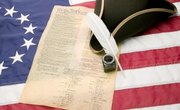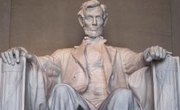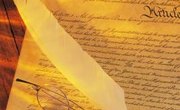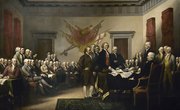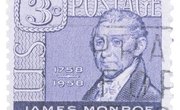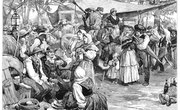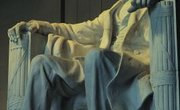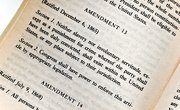The United States Constitution was ratified in 1789, but not without considerable debate. During the Constitutional Convention, delegates debated major issues such as the makeup of the legislature and the effect of slavery on representation. When the new constitution was up for ratification by the states, James Madison, Alexander Hamilton and John Jay had to write a series of pamphlets known as the "Federalist Papers" to convince Americans to ratify the constitution, as many were fearful of the increased power of the federal government.
Articles of Confederation
A new constitution was necessary due to the failure of the colonies' existing form of government under the Articles of Confederation. The Articles, officially ratified in 1781, were written by members of the Second Continental Congress, which had declared independence in 1776 and was overseeing the war effort against Britain. Under the Articles, the federal government was weak: There was no executive branch, and Congress had no power to tax, nor raise a standing army. Shays' Rebellion in 1786, an uprising of disgruntled war veterans, revealed the necessity of a standing army to keep the country unified as well as a need for taxes to pay for government expenditures like a war effort. Recognizing that the Articles were insufficient to govern this new country, the states decided to call a Constitutional Convention in 1787 to meet in Philadelphia.
The Legislature
The major debate between the 55 delegates at the convention was over the type of legislature. Delegates of larger states called for seats in the legislature to be determined proportionally by population, while smaller states wanted each state, no matter the population, to have equal representation in Congress. Ultimately, the delegates would compromise by having a bicameral, or two-house, legislature, which included a House of Representatives determined by population and a Senate where each state had just two representatives. James Madison, architect of the compromise, would argue in "Federalist No. 10" that such a system helps avoid the tyranny of the majority and is essential to a democracy.
Slavery and Representation
The second major issue was between northern and southern states over the issue of slavery. Many of the northern states sought to ban slavery entirely, and, failing that, at least to ban the importation of new slaves. A compromise was reached whereby Congress could legislate against the slave trade, but not until 1808, effectively protecting the trade for another 20 years, during which time there was a substantial rise in the importation of slaves into the South. Additionally, when determining each state's number of seats in the House of Representatives, southern states such as South Carolina wanted their slave population to count towards their total share of representatives, even though the slaves had no legal rights as citizens. A compromise was eventually reached whereby slaves were counted as 3/5 of a person in determining a slave state's representatives.
The Federalist Papers
In addition to these two compromises, the delegates had to convince the states themselves to ratify the new document, even though it would give the central government more power at the states' expense, in contrast to the Articles. This new Constitution created a strong executive branch, which the Articles lacked, and gave Congress the power to tax and raise an army. Between 1787 and 1788, as the states considered ratification of the new Constitution, its primary author, James Madison, along with Alexander Hamilton and John Jay, wrote a series of pamphlets known as the "Federalist Papers," encouraging Americans to ratify the Constitution and convincing them of the need for the strong central government it created. Ultimately, the states agreed to ratify the Constitution only if it included a Bill of Rights, currently the first ten amendments to the Constitution, which protect various individual rights.
Related Articles
References
Writer Bio
Aatif Rashid writes on international politics and culture. His articles have appeared in magazines such as "The Oxonian Globalist" and online at Future Foreign Policy and ThinkPolitic. He holds Bachelor's degrees in English and history from U.C. Berkeley and a Masters degree from the University of Oxford.



